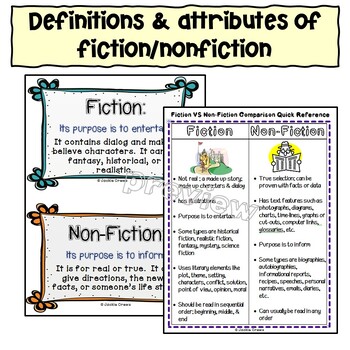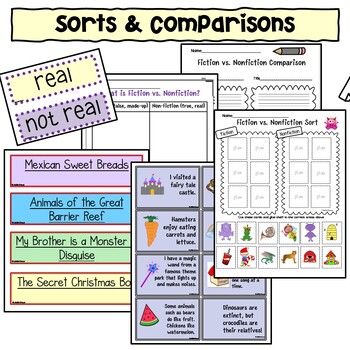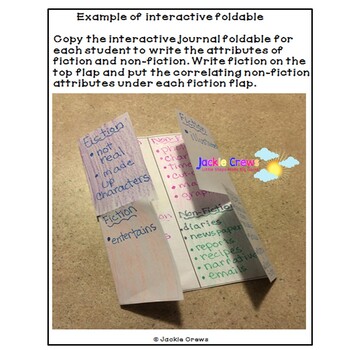Fiction vs Non-Fiction Sorts & Comparisons Differentiated
- PDF
Description
Do you need a resource that will help alleviate any confusion student might have about the differences between fiction and nonfiction? This resource addresses not just the attributes of the two genres, but also gives students a chance to put what they know to use. My favorite part of this packet is the side-by-side comparison of the attributes of fiction vs. nonfiction.
This packet has 29 pages of printable material for grades 1-3. There is a reality/fantasy pocket chart sort in addition to the materials listed below plus an independent fiction/nonfiction picture sort.
ADDITIONALLY, I have added a page of the core language arts/reading standards that inspired me to create this product. I also added ESL Insights, which is a feature I am adding to most of my updated products that will highlight the needs of this growing group of students.
- This resource includes: a mini-poster page explaining fiction and nonfiction that could be enlarged in a poster-maker. It has a fiction/non-fiction title sort, a what is fiction/non-fiction sort, a fiction/non-fiction comparison quick reference for the attributes of the two, an excerpt page for students to determine the text type, pocket chart header cards, pocket chart attribute cards for both fiction and nonfiction, created title cards for pocket chart sorting, an interactive foldable, a photo sample of the foldable, and a differentiated picture sort for emergent readers for real and not real. There is a realistic fiction vs. nonfiction as a challenge to differentiate.
- I added a pocket chart sorting activity for reality vs. fantasy with 16 cards and two header cards because kids sometimes have issues deciding what is real and what is fantasy. There is a page of blank cards if you want to make your own fantasy/reality cards. This will be good for lower performing students or even if you are teaching a fairy tale unit.
- Recent update: I added a few new title cards, new picture cards, and a fiction/non-fiction comparison template for title selections of your choice.
STANDARDS: (This packet was core inspired with first, second, and third grade standards.)
CCSS.ELA-LITERACY.RL.1.2
Retell stories, including key details, and demonstrate understanding of their central message or lesson.
CCSS.ELA-LITERACY.RL.1.3
Describe characters, settings, and major events in a story, using key details
CCSS.ELA-LITERACY.RI.1.7
Use the illustrations and details in a text to describe its key ideas
CCSS.ELA-LITERACY.RL.2.7
Use information gained from the illustrations and words in a print or digital text to demonstrate understanding of its characters, setting, or plot
CCSS.ELA-LITERACY.RL.2.5
Describe the overall structure of a story, including describing how the beginning introduces the story and the ending concludes the action
CCSS.ELA-LITERACY.RL.2.2
Recount stories, including fables and folktales from diverse cultures, and determine their central message, lesson, or moral.
CCSS.ELA-LITERACY.RI.3.7
Use information gained from illustrations (e.g., maps, photographs) and the words in a text to demonstrate understanding of the text (e.g., where, when, why, and how key events occur)
CCSS.ELA-LITERACY.RL.3.2
Recount stories, including fables, folktales, and myths from diverse cultures; determine the central message, lesson, or moral and explain how it is conveyed through key details in the text
My tips for use: What I usually do first is teach the concept whole group and practice whole group first before I send kids to centers or independent practice. This packet allows for that because of the pocket chart sorts. The other sorts could be done independently but they could also be put together into a pocket folder as a center for literacy center times. The picture card sort would be great for a small group of early learners.
You might also be interested in:
Compare & Contrast It! Fiction & Nonfiction Task Card Organizers Literacy Center
Vocabulary Sorts for English Language Learners
Vocabulary Sorts for English Language Learners Part 2
Vocabulary Sorts for English Language Learners BUNDLE
Adjective and Noun Practice for ELLs
Common Sorts for Early Learners
SEQUENCE IT: Task Cards & Practice
Making Sentences With 38 Sight Words For Early Learners
Sentence Builders Multi-Purpose Word Cards For Pocket Charts & Centers
Match & Sort: Sentences with Pictures Winter Themed
SOCIAL MEDIA:





